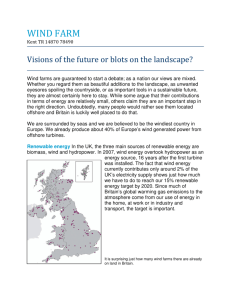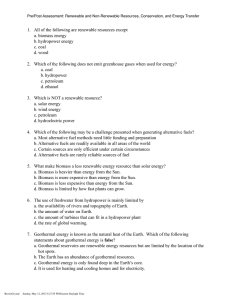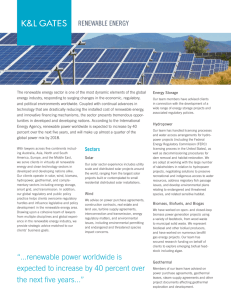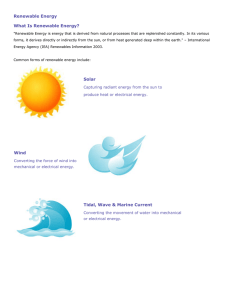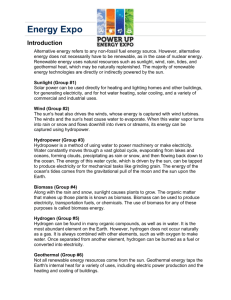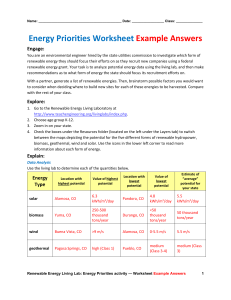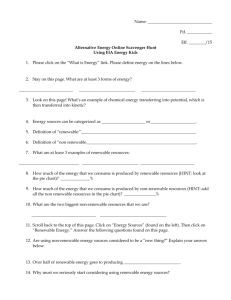(CH 1) Introduction
advertisement
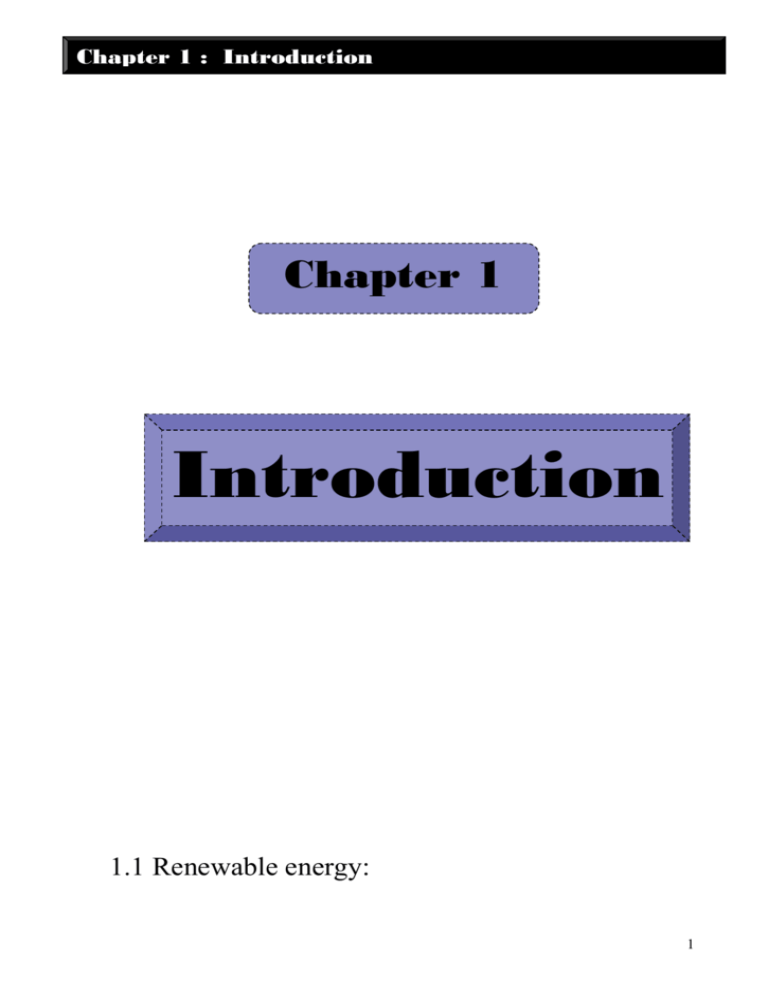
Chapter 1 : Introduction Chapter 1 Introduction 1.1 Renewable energy: 1 Chapter 1 : Introduction is energy which comes from natural resources such as (sunlight, wind, rain, tides, and geothermal heat) . Which does not have a limited supply? Renewable energy can be used again and again, and will never run out. Renewable energy can sometimes be called infinite energy, because it relies on energy that is in infinite supply. -About 16% of global final energy consumption comes from renewable , with 10% coming from traditional biomass , and 3.4% from hydroelectricity , New renewable (small hydro, modern biomass, wind, solar, geothermal, and biofuel) accounted for another 3% and are growing very rapidly. 1.1.1The types of renewable sources of energy :2 Chapter 1 : Introduction 1. Hydropower. 2. Tidal power. 3. Solar energy. 4. Biomass. 5. Geothermal energy. 6. Wind power. 1.1.1.1 Hydropower Hydro-power is the capture of the energy of moving water to generate electric power. This falling of water can be from a natural falling source or from a dam. The falling water is used to turn waterwheels or modern turbine blades which are used to power a generator to produce electricity. A water turbine captures the energy in 3 Chapter 1 : Introduction the falling water and converts the hydraulic energy into mechanical energy at the turbine shaft. Then the alternator converts mechanical energy into electrical energy. The water power is used to generate electric power. This electricity produced by hydro-power is called Hydroelectricity. 1.1.1.2 Tidal power Is a form of hydropower that converts the energy of tides into useful forms of power - mainly electricity The development of tidal energy, which implies generating electricity by using the energy of tides and their cyclical variations. 4 Chapter 1 : Introduction 1.1.1.3 Solar energy:A solar cell, or photovoltaic cell (PV), is a device that converts light into electric current using the photoelectric effect. The science behind photo voltaic is relatively simple. The solar cells will absorb the energy from the sunlight. The entering photons from the sunlight knock the electrons away from their atoms. The electrons are only allowed to flow in one direction and therefore these electrons will be used to produce electricity. 5 Chapter 1 : Introduction 1.1.1.4 Biomass Biomass, as a renewable energy source, is biological material from living, or recently living organisms. As an energy source, biomass can either be used directly, or converted into other energy products such as befoul. 1.1.1.5 Geothermal energy Geothermal energy is thermal energy generated and stored in the Earth. Thermal energy is the energy that determines the temperature of matter. Earth's geothermal energy originates from the original formation of the planet 6 Chapter 1 : Introduction 1.1.1.6 Wind power Wind energy is energy collected from motion caused by heavy winds. Wind energy is collected in turbines with propellers that spin when the wind blows and turn the motion of the propeller into energy that can be used in the electrical grid. Wind energy is a clean, renewable energy source that is abundant in windy areas. Large wind farms are often located outside of cities. Wind turbines come in a variety of sizes that can be used to supply power to individual buildings or feed electricity into a grid system. They must be located above nearby buildings and trees to work effectively for a home or building. Considerations to be taken when installing a wind turbine include location, average wind speed, the height of the surrounding buildings and trees . 7 Chapter 1 : Introduction 1.2 Advantages of wind power:Wind energy is fueled by the wind, so it's a clean fuel source. Wind energy doesn't pollute the air like power plants that rely on combustion of fossil fuels, such as coal or natural gas. 2. Wind turbines don't produce atmospheric emissions that cause acid rain or greenhouse gasses. 1. Wind energy relies on the renewable power of the wind, which can't be used up. 3. Wind energy is one of the lowest running priced renewable energy technologies available today. 4. Wind turbines can be built on farms or ranches, in general the remote areas where most of the best wind sites are found. Because the wind turbines use only a fraction of the land. Wind power plant owners make rent payments to the farmer or rancher for the use of the land 5. 8 Chapter 1 : Introduction 1.3 Distribution of wind speed in Egypt:The strength of wind varies, and an average value for a given location does not alone indicate the amount of energy a wind turbine could produce there. Different locations will have different wind speed distributions. 7. As we can see distribution of wind in Egypt varies from location to another and in the map shown the wind restricted to some locations such as Hurghada, al zaafarana and other locations pointed along on the red sea. 6. 9

